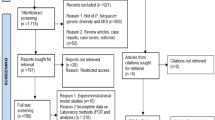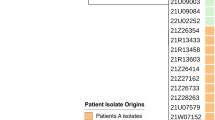Abstract
Pentavalent antimonials remain the treatment of choice for all the clinical forms of leishmaniasis. The increasing rates of antimony resistance are becoming a serious health problem in treatment of anthroponotic cutaneous leishmaniasis (ACL). Accordingly, unraveling molecular markers is crucial for improving medication strategies and monitoring of drug-resistant parasites. Different studies have suggested the importance of genes involved in trypanothione metabolism and drug transport. In this regard, present study was designed to investigate the RNA expression level of five genes including γ-GCS, ODC, TRYR (involved in trypanothione metabolism), AQP1 (acts in drug uptake) and MRPA (involved in sequestration of drug) in sensitive and resistant Leishmania tropica isolates. Seven antimony-resistant and seven antimony-sensitive L. tropica clinical isolates were collected from ACL patients. Drug sensitivity test was performed on the samples as well as reference strains; afterwards, gene expression analysis was performed on clinical isolates by quantitative real-time PCR. The results revealed that the average expression level of AQP1 gene was decreased (0.47-fold) in resistant isolates compared to sensitive ones whereas MRPA (2.45), γ-GCS (2.1) and TRYR (1.97) was upregulated in resistant isolates. The average expression of ODC (1.24-fold) gene was not different significantly between sensitive and resistant isolates. Our findings suggest that AQP1, MRPA, GSH1 and TRYR can be considered as potential molecular markers for screening of antimony resistance in some L. tropica clinical isolates.


Similar content being viewed by others
References
Adaui V, Schnorbusch K, Zimic M, Gutiérrez A, Decuypere S, Vanaerschot M, DE Doncker S, Maes I, Llanos-Cuentas A, Chappuis F, Arévalo J, Dujardin JC (2011) Comparison of gene expression patterns among Leishmania braziliensis clinical isolates showing a different in vitro susceptibility to pentavalent antimony. Parasitology 138:183–193. https://doi.org/10.1017/S0031182010001095
Alvar J, Vélez ID, Bern C, Herrero M, Desjeux P, Cano J, Jannin J, den Boer M, The WHO Leishmaniasis Control Team (2012) Leishmaniasis worldwide and global estimates of its incidence. PLoS One 7:e35671. https://doi.org/10.1371/journal.pone.0035671
Antinori S, Schifanella L, Corbellino M (2012) Leishmaniasis: new insights from an old and neglected disease. Eur J Clin Microbiol Infect Dis 31(2):109–118. https://doi.org/10.1007/s10096-011-1276-0
Biyani N, Singh AK, Mandal S, Chawla B, Madhubala R (2011) Differential expression of proteins in antimony-susceptible and -resistant isolates of Leishmania donovani. Mol Biochem Parasitol 179:91–99. https://doi.org/10.1016/j.molbiopara.2011.06.004
Croft SL, Sundar S, Fairlamb AH (2006) Drug resistance in leishmaniasis. Clin Microbiol Rev 19:111–126. https://doi.org/10.1128/CMR.19.1.111-126.2006
Cunningham ML, Fairlamb AH (1995) Trypanothione reductase from Leishmania donovani. Purification, characterisation and inhibition by trivalent antimonials. Eur J Biochem 230:460–468
Decuypere S, Rijal S, Yardley V, DE Doncker S, Laurent T, Khanal B, Chappuis F, Dujardin JC (2005) Gene expression analysis of the mechanism of natural Sb(V) resistance in Leishmania donovani isolates from Nepal. Antimicrob Agents Chemother 49:4616–4621. https://doi.org/10.1128/AAC.49.11.4616-4621.2005
Monte-Neto D, Coelho RL, Raymond AC, Legare F, Corbeil D, Melo J, Frezard MN, Ouellette F, M (2011) Gene expression profiling and molecular characterization of antimony resistance in Leishmania amazonensis. PLoS Negl Trop Dis 5:e1167. https://doi.org/10.1371/journal.pntd.0001167
El Fadili K, Messier N, Leprohon P, Roy G, Guimond C, Trudel N, Saravia NG, Papadopoulou B, Legare D, Ouellette M (2005) Role of the ABC transporter MRPA (PGPA) in antimony resistance in Leishmania infantum axenic and intracellular amastigotes. Antimicrob Agents Chemother 49:1988–1993. https://doi.org/10.1128/AAC.49.5.1988-1993.2005
Gourbal B, Sonuc N, Bhattacharjee H, Legare D, Sundar S, Ouellette M, Rosen BP, Mukhopadhyay R (2004) Drug uptake and modulation of drug resistance in Leishmania by an aquaglyceroporin. J Biol Chem 279:31010–31017. https://doi.org/10.1074/jbc.M403959200
Grondin K, Haimeur A, Mukhopadhyay R, Rosen BP, Ouellette M (1997) Co-amplification of the γ-glutamylcysteine synthetase gene gsh1 and of the ABC transporter gene pgpA in arsenite-resistant Leishmania tarentolae. EMBO J 16:3057–3065
Hadighi R, Mohebali M, Boucher P, Hajjaran H, Khamesipour A, Ouellette M (2006) Unresponsiveness to Glucantime treatment in Iranian cutaneous leishmaniasis due to drug-resistant Leishmania tropica parasites. PLoS Med 3:e162. https://doi.org/10.1371/journal.pmed.0030162
Haimeur A, Guimond C, Pilote S, Mukhopadhyay R, Rosen BP, Poulin R, Ouellette M (2002) Elevated levels of polyamines and trypanothione resulting from overexpression of the ornithine decarboxylase gene in arsenite-resistant Leishmania. Mol Microbiol 34:726–735
Hajjaran H, Azarian B, Mohebali M, Hadighi R, Assareh A, Vaziri B (2012) Comparative proteomics study on meglumine antimoniate sensitive and resistant Leishmania tropica isolated from Iranian anthroponotic cutaneous leishmaniasis patients. East Mediterr Health J 18(2):165–171
Jeddi F, Mary C, Aoun K, Harrat Z, Bouratbine A, Faraut F, Benikhlef R, Pomares C, Pratlong F, Marty P, Piarroux R (2014) Heterogeneity of molecular resistance patterns in antimony-resistant field isolates of Leishmania species from the western Mediterranean area. Antimicrob Agents Chemother 58(8):4866–4874. https://doi.org/10.1128/AAC.02521-13
Kazemi-Rad E, Mohebali M, Khadem-Erfan MB, Saffari M, Raoofian R, Hajjaran H, Hadighi R, Khamesipour A, Rezaie S, Abedkhojasteh H, Heidari M (2013) Identification of antimony resistance markers in Leishmania tropica field isolates through a cDNA-AFLP approach. Exp Parasitol 135(2):344–349. https://doi.org/10.1016/j.exppara.2013.07.018
Kumar D, Singh R, Bhandari V, Kulshrestha A, Negi NS, Salotra P (2012) Biomarkers of antimony resistance: need for expression analysis of multiple genes to distinguish resistance phenotype in clinical isolates of Leishmania donovani. Parasitol Res 111:223–230. https://doi.org/10.1007/s00436-012-2823-z
Légaré D, Richard D, Mukhopadhyay R, Stierhof YD, Rosen BP, Haimeur A, Papadopoulou B, Ouellette M (2001) The Leishmania ATP-binding cassette protein PGPA is an intracellular metal-thiol transporter ATPase. J Biol Chem 276:26301–26307. https://doi.org/10.1074/jbc.M102351200
Livak KJ, Schmittgen TD (2001) Analysis of relative gene expression data using real-time quantitative PCR and the \({2^{ - \Delta \Delta {C_{\text{t}}}}}\) method. Methods 25:402–408. https://doi.org/10.1006/meth.2001
Mandal S, Maharjan M, Singh S, Chatterjee M, Madhubala R (2010) Assessing aquaglyceroporin gene status and expression profile in antimony-susceptible and -resistant clinical isolates of Leishmania donovani from India. J Antimicrob Chemother 65:496–507. https://doi.org/10.1093/jac/dkp468
Marquis N, Gourbal B, Rosen BP, Mukhopadhyay R, Ouellette M (2005) Modulation in aquaglyceroporin AQP1 gene transcript levels in drug-resistant Leishmania. Mol Microbiol 57:1690–1699. https://doi.org/10.1111/j.1365-2958.2005.04782.x
Mashayekhi Goyonlo V, Elnour H, Nordlind K (2014) Serotonin transporter protein overexpression and association to Th17 and T regulatory cells in lupoid leishmaniasis. Arch Dermatol Res 306(2):181–188. https://doi.org/10.1007/s00403-013-1395-9
Mittal MK, Rai S, Gupta S, Sundar S, Goyal N (2007) Characterization of natural antimony resistance in Leishmania donovani isolates. Am J Trop Med Hyg 76(4):681–688
Mukherjee A, Padmanabhan PK, Singh S, Roy G, Girard I, Chatterjee M, Ouellette M, Madhubala R (2007) Role of ABC transporter MRPA, gamma-glutamylcysteine synthetase and ornithine decarboxylase in natural antimony-resistant isolates of Leishmania donovani. J Antimicrob Chemother 59:204–211. https://doi.org/10.1093/jac/dkl494
Murray HW, Berman JD, Davies CR, Saravia NG (2005) Advances in leishmaniasis. Lancet 366:1561–1577. https://doi.org/10.1016/S0140-6736(05)67629-5
Nafchi HR, Kazemi-Rad E, Mohebali M, Raoofian R, Ahmadpour NB, Oshaghi MA, Hajjaran H (2016) Expression analysis of viscerotropic leishmaniasis gene in Leishmania species by real-time RT-PCR. Acta Parasitol 61(1):93–97. https://doi.org/10.1515/ap-2016-0011
Plourde M, Coelho A, Keynan Y, Larios OE, Ndao M, Ruest A, Roy G, Rubinstein E, Ouellette M (2012) Genetic polymorphisms and drug susceptibility in four isolates of Leishmania tropica obtained from Canadian soldiers returning from Afghanistan. PLoS Negl Trop Dis 6(1):e1463. https://doi.org/10.1371/journal.pntd.0001463
Rai S, Bhaskar, Goel SK, Nath Dwivedi U, Sundar S, Goyal N (2013) Role of efflux pumps and intracellular thiols in natural antimony resistant isolates of Leishmania donovani. PLoS One 8(9):e74862. https://doi.org/10.1371/journal.pone.0074862
Sereno D, Cavaleyra M, Zemzoumi K, Maquaire S, Ouaissi A, Lemesre J (1998) Axenically grown amastigotes of Leishmania infantum used as an in vitro model to investigate the pentavalent antimony mode of action. Antimicrob Agents Chemother 42:3097–3102
Shaked-Mishan P, Ulrich N, Ephros M, Zilberstein D (2001) Novel intracellular SbV reducing activity correlates with antimony susceptibility in Leishmania donovani. J Biol Chem 276:3971–3976. https://doi.org/10.1074/jbc.M005423200
Shirzadi MR, Esfahania SB, Mohebalia M, Ershadia MR, Gharachorlo F, Razavia MR, Postigo JA (2012) Epidemiological status of leishmaniasis in the Islamic Republic of Iran, 1983–2012. East Mediterr Health J 21(10):736–742
Singh N, Chatterjee M, Sundar S (2014) The overexpression of genes of thiol metabolism contribute to drug resistance in clinical isolates of visceral leishmaniasis (kala azar) in India. Parasites Vectors 17(7):596. https://doi.org/10.1186/s13071-014-0596-1
Torres DC, Adaui V, Ribeiro-Alves M, Romero GA, Arévalo J, Cupolillo E, Dujardin JC (2010) Targeted gene expression profiling in Leishmania braziliensis and Leishmania guyanensis parasites isolated from Brazilian patients with different antimonial treatment outcomes. Infect Genet Evol 10(6):727–733. https://doi.org/10.1016/j.meegid.2010.05.006
Yan S, Li F, Ding K, Sun H (2003) Reduction of pentavalent antimony by trypanothione and formation of a binary and ternary complex of antimony(III) and trypanothione. J Biol Inorg Chem 8:689–697. https://doi.org/10.1007/s00775-003-0468-1
Acknowledgements
The authors would like to express their gratitude to Dr. S.R. Naddaf, Mrs. S. Charedar, Dr. M. Saffari and Dr. B. Akhoondi for their kind cooperation.
Funding
This research has been supported by Tehran University of Medical Sciences and health Services Grant no. 93-02-27-25242.
Author information
Authors and Affiliations
Corresponding author
Ethics declarations
Conflict of interest
The authors declare that they have no conflict of interest.
Ethical approval
The study was approved by the Ethics Research Committee of the School of Public Health, Tehran University of Medical Sciences.
Informed consent
Informed consent was obtained from all individual participants included in the study.
Rights and permissions
About this article
Cite this article
Mohebali, M., Kazemirad, E., Hajjaran, H. et al. Gene expression analysis of antimony resistance in Leishmania tropica using quantitative real-time PCR focused on genes involved in trypanothione metabolism and drug transport. Arch Dermatol Res 311, 9–17 (2019). https://doi.org/10.1007/s00403-018-1872-2
Received:
Revised:
Accepted:
Published:
Issue Date:
DOI: https://doi.org/10.1007/s00403-018-1872-2




